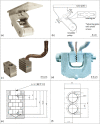Cyclic tensile tests of Shetland pony superficial digital flexor tendons (SDFTs) with an optimized cryo-clamp combined with biplanar high-speed fluoroscopy
- PMID: 34172051
- PMCID: PMC8229380
- DOI: 10.1186/s12917-021-02914-w
Cyclic tensile tests of Shetland pony superficial digital flexor tendons (SDFTs) with an optimized cryo-clamp combined with biplanar high-speed fluoroscopy
Abstract
Background: Long-term cyclic tensile testing with equine palmar/plantar tendons have not yet been performed due to problems in fixing equine tendons securely and loading them cyclically. It is well established that the biomechanical response of tendons varies during cyclic loading over time. The aim of this study was to develop a clamping device that enables repetitive cyclic tensile testing of equine superficial digital flexor tendon for at least 60 loading cycles and for 5 min.
Results: A novel cryo-clamp was developed and built. Healthy and collagenase-treated pony SDFTs were mounted in the custom-made cryo-clamp for the proximal tendon end and a special clamping device for the short pastern bone (os coronale). Simultaneously with tensile testing, we used a biplanar high-speed fluoroscopy system (FluoKin) to track tendon movement. The FluoKin system was additionally validated in precision measurements. During the cyclic tensile tests of the SDFTs, the average maximal force measured was 325 N and 953 N for a length variation of 2 and 4 % respectively. The resulting stress averaged 16 MPa and 48 MPa respectively, while the modulus of elasticity was 828 MPa and 1212 MPa respectively. Length variation of the metacarpal region was, on average, 4.87 % higher after incubation with collagenase. The precision of the FluoKin tracking was 0.0377 mm, defined as the standard deviation of pairwise intermarker distances embedded in rigid bodies. The systems accuracy was 0.0287 mm, which is the difference between the machined and mean measured distance.
Conclusion: In this study, a good performing clamping technique for equine tendons under repetitive cyclic loading conditions is described. The presented cryo-clamps were tested up to 50 min duration and up to the machine maximal capacity of 10 kN. With the possibility of repetitive loading a stabilization of the time-force-curve and changes of hysteresis and creep became obvious after a dozen cycles, which underlines the necessity of repetitive cyclical testing. Furthermore, biplanar high-speed fluoroscopy seems an appropriate and highly precise measurement tool for analysis of tendon behaviour under repetitive load in equine SDFTs.
Keywords: Cryo-clamp; Equine; Horse; Strain; Superficial digital flexor tendon (SDFT); XROMM.
Conflict of interest statement
The authors declare that they have no competing interests.
Figures






Similar articles
-
Biplanar High-Speed Fluoroscopy of Pony Superficial Digital Flexor Tendon (SDFT)-An In Vivo Pilot Study.Vet Sci. 2021 May 27;8(6):92. doi: 10.3390/vetsci8060092. Vet Sci. 2021. PMID: 34072030 Free PMC article.
-
Influence of track surface on the equine superficial digital flexor tendon loading in two horses at high speed trot.Equine Vet J. 2009 Mar;41(3):257-61. doi: 10.2746/042516409x394445. Equine Vet J. 2009. PMID: 19469232
-
Comparison of superficial digital flexor tendon loading on asphalt and sand in horses at the walk and trot.Vet J. 2013 Dec;198 Suppl 1:e130-6. doi: 10.1016/j.tvjl.2013.09.047. Epub 2013 Sep 26. Vet J. 2013. PMID: 24360732
-
Mechanical and functional properties of the equine superficial digital flexor tendon.Vet J. 2005 Sep;170(2):184-92. doi: 10.1016/j.tvjl.2004.03.021. Vet J. 2005. PMID: 16129339 Review.
-
Muscle-tendon stresses and elastic energy storage during locomotion in the horse.Comp Biochem Physiol B Biochem Mol Biol. 1998 May;120(1):73-87. doi: 10.1016/s0305-0491(98)00024-8. Comp Biochem Physiol B Biochem Mol Biol. 1998. PMID: 9787779 Review.
Cited by
-
Biplanar High-Speed Fluoroscopy of Pony Superficial Digital Flexor Tendon (SDFT)-An In Vivo Pilot Study.Vet Sci. 2021 May 27;8(6):92. doi: 10.3390/vetsci8060092. Vet Sci. 2021. PMID: 34072030 Free PMC article.
-
Clinical benefits of early-stage autologous conditioned serum and injectable platelet-rich fibrin on healing superficial digital flexor tendonitis in donkeys.Ir Vet J. 2025 Jun 7;78(1):13. doi: 10.1186/s13620-025-00299-y. Ir Vet J. 2025. PMID: 40483508 Free PMC article.
References
MeSH terms
LinkOut - more resources
Full Text Sources

